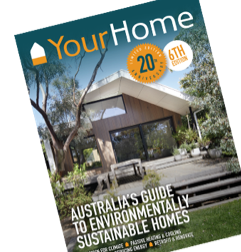Search
-
Two new townhouses and two new apartments using reverse brick veneer and straw bales.
-
Two new apartments that use passive solar design principles, solar and water technologies, and smart home systems on a small suburban infill block.
-
Key points
- Thermal mass is the ability of a material to absorb, store and release heat. Thermal lag is the rate at which a material releases stored heat. For most common building materials, the higher the thermal mass, the longer the thermal lag.
-
Key points
- Brickwork and blockwork are the most common materials used for residential buildings.
- Brick and blockwork are materials used in masonry construction, which also include concrete, stone, manufactured stone, timbercrete and glass.
-
Key points
- Rammed earth walls are constructed by ramming a mixture of gravel, sand, silt and a small amount of clay into place between flat panels called formwork.
- Stabilised rammed earth adds a small amount of cement (typically 5–10%) to increase strength and durability.
-
A community housing project that transformed a former Sydney depot into an urban renewal apartment complex, reflecting the character and cultural significa
-
Key points
- Autoclaved aerated concrete (AAC) is concrete that has been manufactured to contain closed air pockets. AAC is one-fifth the weight of concrete.
- AAC is available as panels and blocks. AAC wall panels are typically used for cladding, but can also be loadbearing. AAC floor and roof panels are also available.
-
Key points
- Straw bales were first used for building soon after the invention of baling machines over a century ago.
- With straw bale construction, bales are usually attached to a frame and laid like giant bricks. Bales are compressed to minimise settlement and movement.
-
New build using some structure of the old house and reverse block brick veneer and a Trombe wall
-
Case studies in this section are specific to Australian Climate Zones 5, 6.
-
Key points
- Lightweight framing using timber or steel is the most common form of framing used in Australian homes.
- Lightweight framing can be easily adapted to suit the site. It can also be combined with a wide range of cladding options to suit your climate, site and design.
-
Abatement
Activity that leads to a reduction in the level of greenhouse gas emissions.
Abutment
A structure built to support the lateral pressure of an arch or span, for example at the ends of a bridge.
AccuRate
-
Renovation using double glazing and effective gap sealing.
-
New home using reverse brick veneer and insulation.
-
Key points
- Construction and demolition produces about 40% of Australia’s total waste. Much of that waste can be recycled.
- Reducing construction waste reduces your environmental impact. It may also save money by reducing materials costs and landfill levies.
-
Key points
- Landscaping and garden design can improve your home’s amenity, thermal performance, and value, and can reduce your environmental footprint.
-
Key points
- Appliances and equipment – including your kitchen and laundry appliances, TV, home entertainment, and office equipment – are a key factor in the energy use of your home. Home appliances and equipment use an average of 25% of household energy.


